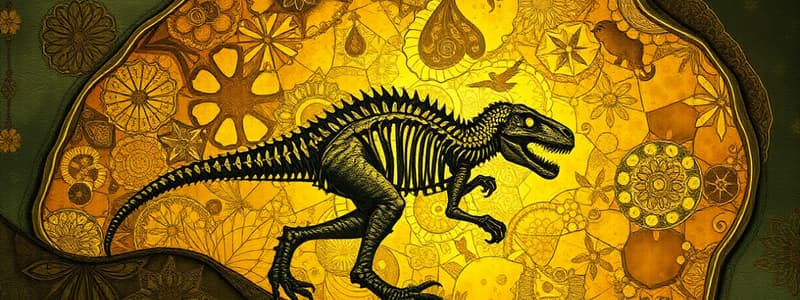Podcast
Questions and Answers
What is the first step in the fossil formation process?
What is the first step in the fossil formation process?
- Sediment turns to rock
- The rock erodes and exposes the fossil
- An organism is buried under sediment (correct)
- Minerals replace the remains
Which method is used to determine the age of fossils based on the amount of radioactive carbon dioxide remaining in the body?
Which method is used to determine the age of fossils based on the amount of radioactive carbon dioxide remaining in the body?
- Index fossil dating
- Relative dating
- Stratigraphic dating
- Absolute dating (correct)
What crucial process must occur quickly after an organism dies for a fossil to potentially form?
What crucial process must occur quickly after an organism dies for a fossil to potentially form?
- The organism must decompose rapidly
- The organism must be buried quickly (correct)
- The organism must be exposed to air
- The organism must be frozen instantly
What happens to the fossil as rock layers accumulate over time?
What happens to the fossil as rock layers accumulate over time?
How can scientists determine the age of a fossil by counting layers of rock?
How can scientists determine the age of a fossil by counting layers of rock?
What is the first step in fossil formation?
What is the first step in fossil formation?
What happens to the sediment that covers a dead organism during fossil formation?
What happens to the sediment that covers a dead organism during fossil formation?
How are fossils often flattened?
How are fossils often flattened?
What does RCD stand for?
What does RCD stand for?
Living things constantly absorb radioactive carbon dioxide (RCD) into their bodies.
Living things constantly absorb radioactive carbon dioxide (RCD) into their bodies.
What happens to the intake of RCD when an organism dies?
What happens to the intake of RCD when an organism dies?
What happens to RCD after death?
What happens to RCD after death?
What is the method of dating fossils called that involves measuring RCD?
What is the method of dating fossils called that involves measuring RCD?
What is another way to calculate the age of fossils?
What is another way to calculate the age of fossils?
What is a fossil?
What is a fossil?
Fossils are only found in rock.
Fossils are only found in rock.
What is the process that leads to fossil formation when an organism is buried quickly after death?
What is the process that leads to fossil formation when an organism is buried quickly after death?
Flashcards
Fossil Formation
Fossil Formation
Process of preserving plant or animal remains as fossils in rocks
Fossil
Fossil
Preserved part or trace of ancient plant or animal, found in rock
Sedimentary Rock
Sedimentary Rock
Rock formed from layers of sediment, often containing fossils
Absolute Dating
Absolute Dating
Signup and view all the flashcards
Radioactive Carbon (RCD)
Radioactive Carbon (RCD)
Signup and view all the flashcards
Fossil Burial
Fossil Burial
Signup and view all the flashcards
Rock Layers
Rock Layers
Signup and view all the flashcards
Fossil Dating Methods
Fossil Dating Methods
Signup and view all the flashcards
Mineral
Mineral
Signup and view all the flashcards
Igneous Rock
Igneous Rock
Signup and view all the flashcards
Sedimentary Rock
Sedimentary Rock
Signup and view all the flashcards
Metamorphic Rock
Metamorphic Rock
Signup and view all the flashcards
Crystallization
Crystallization
Signup and view all the flashcards
Earth's Crust
Earth's Crust
Signup and view all the flashcards
Asthenosphere
Asthenosphere
Signup and view all the flashcards
Mantle
Mantle
Signup and view all the flashcards
Outer/Inner Core
Outer/Inner Core
Signup and view all the flashcards
Extrusive Igneous Rock
Extrusive Igneous Rock
Signup and view all the flashcards
Intrusive Igneous Rock
Intrusive Igneous Rock
Signup and view all the flashcards
Weathering
Weathering
Signup and view all the flashcards
Erosion
Erosion
Signup and view all the flashcards
Cementation
Cementation
Signup and view all the flashcards
Compaction
Compaction
Signup and view all the flashcards
Study Notes
Fossil Formation
- Fossils form when something dies and is covered by sediment.
- Sediment turns to rock, transforming the organism into a fossil.
- Layers of rock may flatten the fossil.
- Fossils can be seen on the surface of rocks after erosion.
Radioactive Carbon Dating
- Radioactive carbon (RCD) is naturally present in the air and living organisms.
- Living things constantly incorporate RCD into their tissues.
- After death, the intake of RCD stops.
- RCD slowly breaks down to its non-radioactive form.
- By calculating the remaining RCD, scientists can determine the time of death (absolute dating).
- This method helps determine the age of fossils.
Fossil Age Calculation
- Fossils' ages can also be determined by counting rock layers.
- Fossils are preserved parts or traces of organisms, often found in rocks.
- Organisms are buried quickly after death to prevent decay.
- Minerals gradually replace the organism's remains over time.
Studying That Suits You
Use AI to generate personalized quizzes and flashcards to suit your learning preferences.




